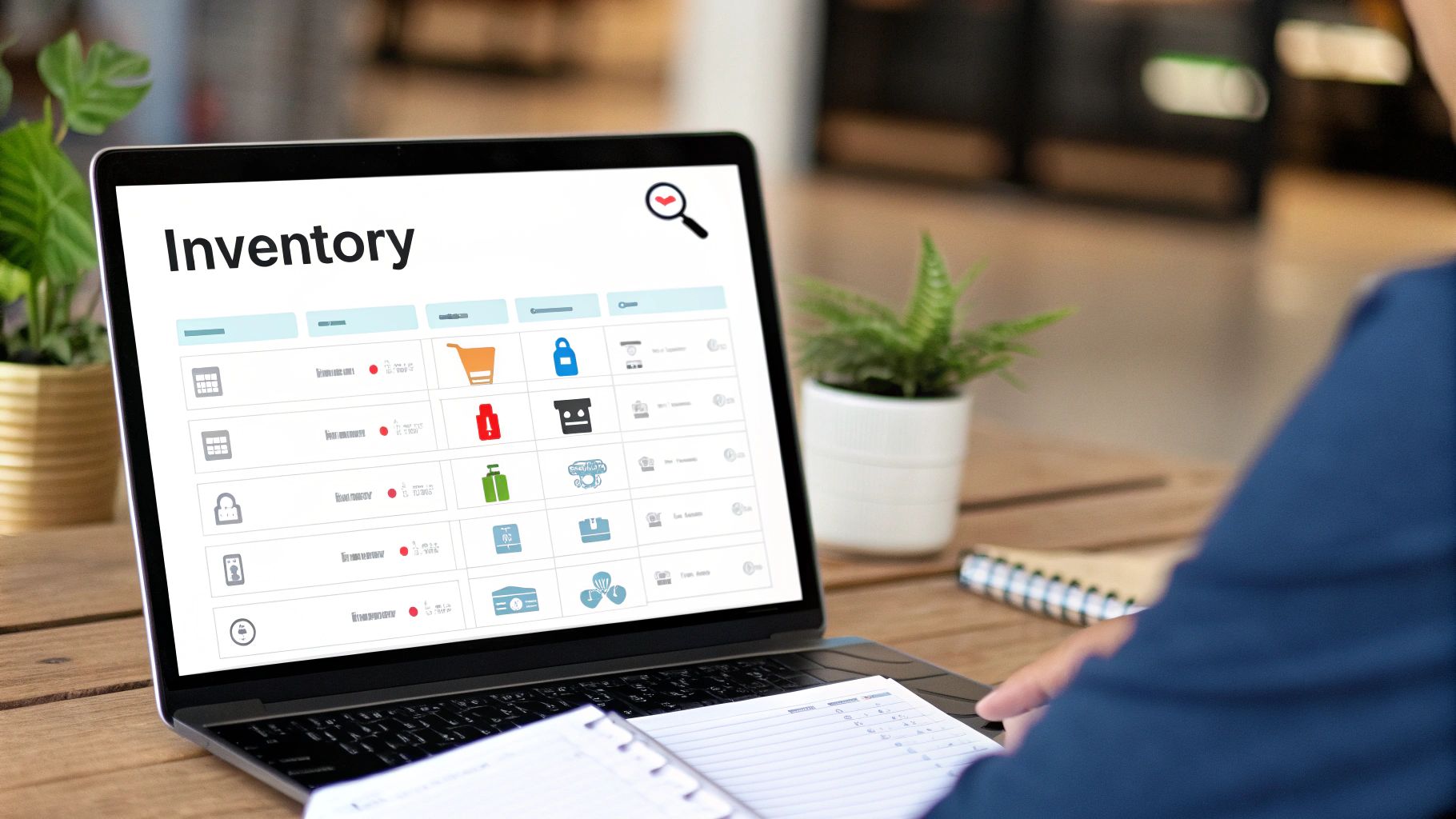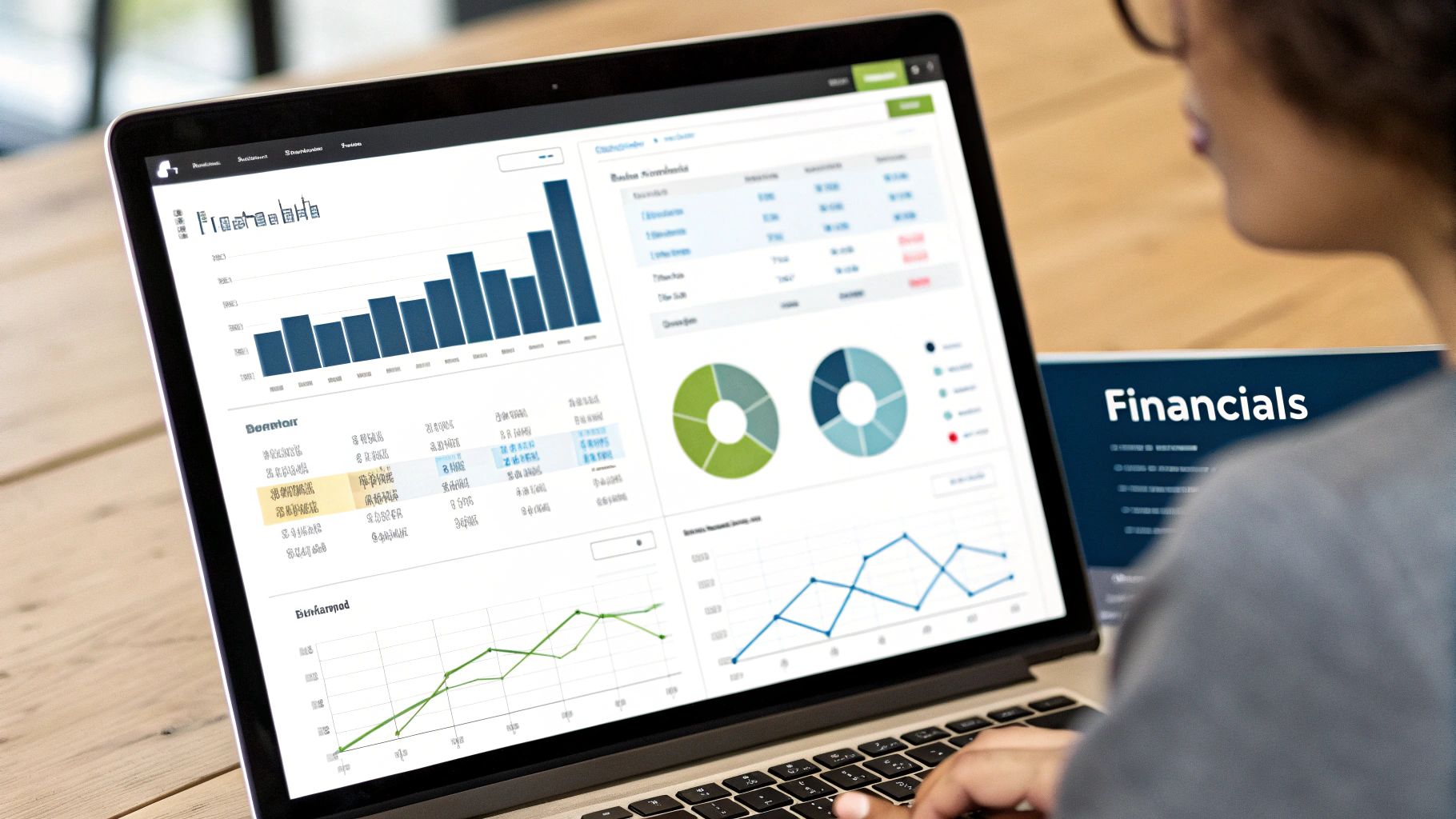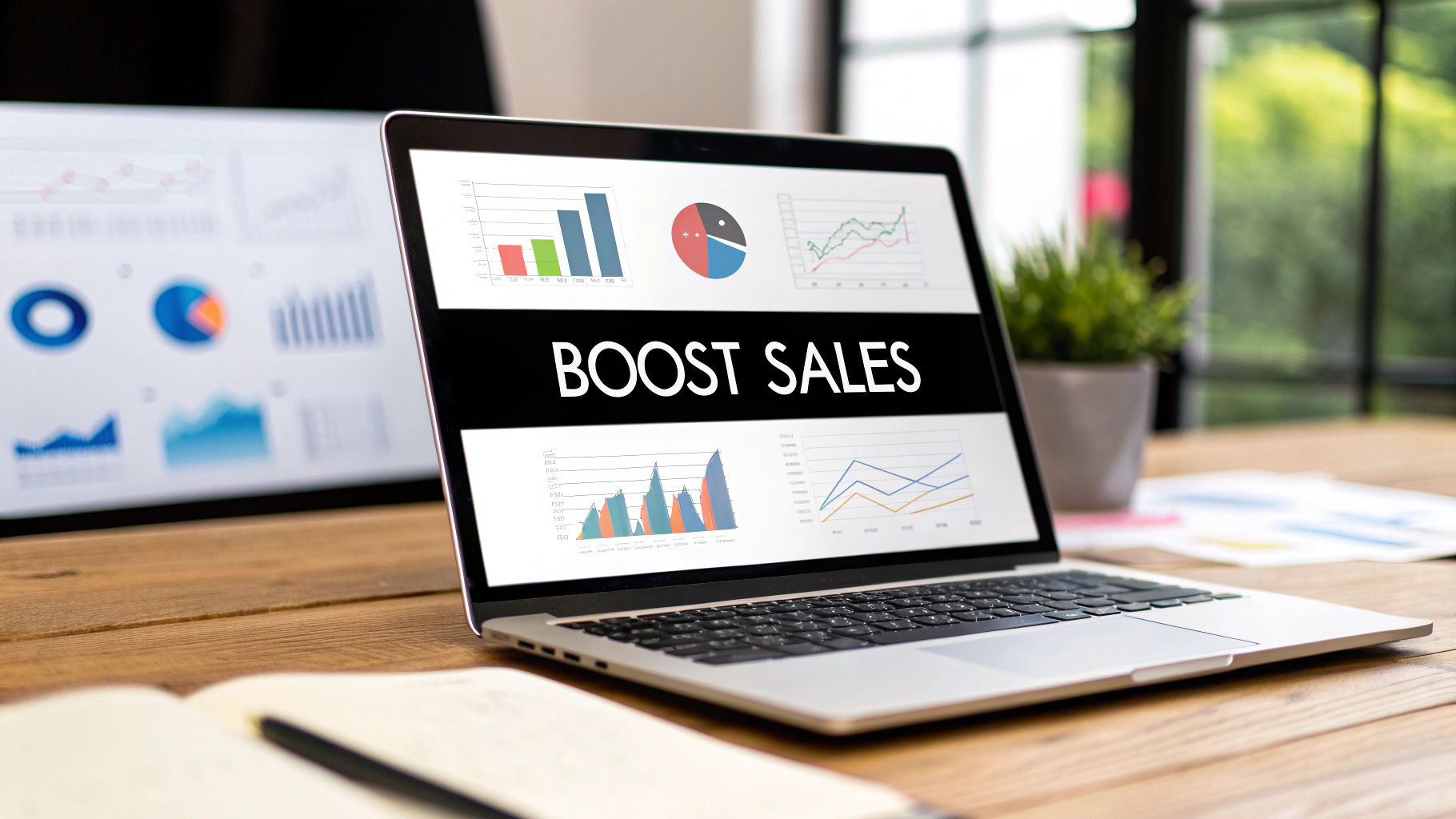Why Your Online Store Needs an Ecommerce Dashboard Now
The world of online retail thrives on data. For ecommerce businesses to succeed, understanding customer behavior and market trends is essential. This applies to businesses of all sizes. Even smaller merchants use data-driven strategies to stay competitive. An ecommerce dashboard provides the essential insights needed to succeed in this environment.
A good ecommerce dashboard empowers businesses to make informed decisions. Instead of guessing, you can anticipate market shifts and understand the financial impact of your strategies. This data-driven approach separates successful businesses from the rest.
Imagine two competing online clothing stores. One relies on intuition to predict fashion trends. The other uses an ecommerce dashboard to analyze real-time search data, social media engagement, and sales patterns. The latter is much better positioned to anticipate demand, optimize inventory, and maximize profits. Real-time analysis is crucial for agility in this fast-paced industry.
The UK ecommerce market highlights the growing importance of data analysis. 62.1 million people are projected to use ecommerce platforms in the UK by 2025, up from almost 60 million in 2023. This increase in online shoppers emphasizes the need for businesses to track key metrics. These metrics include online spending per shopper, which averages around $4,679, and the impact of major platforms like Amazon and Shopify. You can learn more about this at Analyzify. A strong ecommerce dashboard becomes even more important in this competitive landscape.

Benefits of Using a Robust Ecommerce Dashboard
An ecommerce dashboard acts as a central hub for your key performance indicators (KPIs). This offers several important advantages:
- Real-Time Monitoring: Track sales, inventory, website traffic, and other important metrics instantly.
- Data-Driven Decisions: Make strategic choices based on solid data, not guesswork.
- Improved Efficiency: Find and fix problems in your sales process.
- Enhanced Customer Understanding: Analyze customer behavior to personalize marketing and improve user experience.
- Competitive Advantage: Stay ahead of the competition by spotting new trends and market changes.
Choosing the Right Ecommerce Dashboard
Choosing the right ecommerce dashboard is key to realizing these benefits. Consider these factors:
- Integration with Existing Platforms: Make sure the dashboard integrates seamlessly with your current ecommerce platform, marketing tools, and other software.
- Customization Options: Choose a dashboard that lets you tailor metrics and visualizations to your specific needs.
- User-Friendliness: Select a dashboard with an intuitive interface that's easy for your team to use.
- Scalability: Pick a dashboard that can grow with your business and adapt to changing data needs.
An ecommerce dashboard is an investment in your business's future. By providing the insights you need to make smart decisions, it helps you not just survive, but thrive in the competitive world of online retail.
Essential Metrics Every Ecommerce Dashboard Must Track
Effective ecommerce dashboards don't just display data; they highlight the key performance indicators (KPIs) that truly matter. Focusing on the right metrics can significantly impact your bottom line. This section explores the essential data points that drive sustainable growth and offers a framework for prioritizing them according to your unique business needs. It's about refining your data analysis to focus on what truly drives success.
Revenue Accelerators: Fueling Your Growth
Understanding how your business generates revenue is fundamental. These key metrics offer valuable insight into core revenue drivers and pinpoint areas ripe for improvement. They illustrate how effectively you're converting visitors into paying customers and maximizing the value of each transaction.
-
Conversion Rates by Channel: Knowing which channels, like organic search, social media, or email marketing, are most effective at turning visitors into customers helps focus your marketing spend. This is like identifying the strongest tributaries feeding your revenue stream.
-
Average Order Value (AOV) Trends: Monitoring AOV trends helps uncover opportunities to upsell and cross-sell. For example, a declining AOV might suggest exploring product bundles or introducing free shipping thresholds.
-
Customer Lifetime Value (CLV): CLV represents the total revenue you can expect from a single customer over their relationship with your business. Prioritizing customer retention and implementing loyalty programs are crucial for maximizing CLV.
Customer Journey Indicators: Understanding Your Audience
These metrics provide a crucial understanding of how customers interact with your store. From their initial discovery to repeat purchases, analyzing these interactions helps optimize the customer experience and reveal areas for improvement.
-
Acquisition Source Effectiveness: Knowing where your customers originate from, such as Google Ads or social media referrals, helps allocate your marketing budget strategically.
-
Engagement Patterns Across Devices: Analyzing how customers behave on various devices—desktops, mobile phones, and tablets—informs website design and user experience optimization. A consistent and engaging experience across all platforms is key.
-
Retention Rates by Segment: Tracking retention rates within specific customer groups allows for targeted campaigns and more personalized experiences.
Operational Excellence Markers: Streamlining Your Processes
These metrics illuminate the efficiency of your back-end operations, encompassing inventory management, order fulfillment, and other critical processes. Optimizing these areas leads to cost savings and greater customer satisfaction.
-
Inventory Turnover Velocity: Measuring how quickly your inventory sells prevents stockouts and minimizes storage costs. It’s about finding the right balance between supply and demand.
-
Fulfillment Speed Metrics: Tracking order processing and shipping times pinpoints bottlenecks and streamlines logistics. Faster fulfillment often translates to happier customers.
-
Return Rate Patterns: Monitoring product-specific return rates can uncover quality issues or sizing discrepancies. Addressing these issues reduces processing and restocking costs.
To help visualize the connection between business goals and the metrics that matter most, consult the table below:
Understanding which metrics to prioritize is critical for achieving your business objectives. The table below organizes key ecommerce metrics based on different strategic focuses.
| Business Goal | Primary Metrics | Secondary Metrics | Warning Indicators |
|---|---|---|---|
| Increase Sales | Conversion Rate, Average Order Value (AOV) | Website Traffic, Cart Abandonment Rate | Declining conversion rates, stagnant AOV |
| Improve Customer Retention | Customer Lifetime Value (CLV), Repeat Purchase Rate | Churn Rate, Customer Satisfaction Score | Decreasing CLV, rising churn rate |
| Optimize Marketing ROI | Conversion Rate by Channel, Cost per Acquisition (CPA) | Click-Through Rate (CTR), Return on Ad Spend (ROAS) | High CPA, low ROAS |
| Enhance Operational Efficiency | Inventory Turnover, Fulfillment Speed | Order Defect Rate, Return Rate | Slow inventory turnover, increasing return rate |
By understanding these core metrics and their relationship to your overarching goals, you can build a more effective and informative dashboard.
Prioritizing Your Metrics
The optimal metrics for your ecommerce dashboard depend on your unique business model and current goals. A startup might focus on acquisition and conversion rates, while an established brand might prioritize CLV and retention. Select the metrics that align with your current strategic objectives and offer actionable insights. Your dashboard should be a dynamic tool, evolving alongside your business.
Your ecommerce dashboard is a powerful asset for driving growth and optimizing your online store. Tracking these essential metrics gives you the data-driven insights needed to make smart decisions and maintain a competitive edge.
Building a Security-First Ecommerce Dashboard

For any ecommerce business, security is paramount. It's not just a technical requirement, but a core business function tied directly to customer trust and revenue. Integrating security monitoring into your ecommerce dashboard is a crucial business advantage. A security-focused dashboard proactively protects your business and builds customer confidence.
Visualizing Security Threats in Real Time
One of the most effective ways to enhance security is through real-time threat visualization. Imagine a dashboard displaying geographical transaction locations. This allows you to quickly identify unusual activity, like a sudden increase in orders from a country where you don't usually operate. This immediate visibility empowers you to act swiftly, potentially preventing fraudulent transactions. Visualizations transform raw data into actionable insights.
Visualizing transaction patterns can also reveal subtle anomalies that might otherwise be missed. A sudden spike in high-value purchases from new accounts could be a red flag. By setting up automated alerts based on these patterns, your ecommerce dashboard becomes an early warning system. Early detection minimizes potential losses and protects your reputation.
Ecommerce fraud is a serious and growing problem. In 2022, global ecommerce fraud resulted in about $41 billion in losses, a number expected to climb. Find more detailed statistics here. This highlights the critical need for fraud detection tools in your ecommerce dashboard. Implementing secure payment methods like digital wallets and ensuring HTTPS protocols can also enhance trust and minimize fraud.
Monitoring and Measuring Security Performance
Beyond visualization, your dashboard should facilitate proactive security metric monitoring. Tracking login attempts from suspicious IP addresses or monitoring declined transactions provides valuable insights into potential vulnerabilities. These data points help you strengthen your security posture.
Measuring your security program's effectiveness is also essential. By tracking metrics like fraud detection rates and chargeback ratios, you quantify the impact of security investments. This data-driven approach ensures your security strategy remains effective and adaptable to evolving threats. This continuous monitoring and evaluation is crucial for long-term success.
Turning Security into a Competitive Advantage
Transparency about your security practices can build customer confidence and encourage repeat business. Consider displaying security badges or certifications on your website and during checkout. These visible cues reassure customers that their data is safe, differentiating you in a competitive market. Demonstrating your security commitment fosters trust and builds customer loyalty. A secure ecommerce experience benefits everyone.
Using Your Ecommerce Dashboard to Spot Market Shifts

Resilient ecommerce businesses don't just focus internally. They also keep a close watch on the broader market. Your ecommerce dashboard can be a powerful tool for identifying crucial external factors. This involves understanding everything from industry trends and seasonal patterns to competitor activity. By configuring your dashboard to capture these insights, you can adapt quickly and stay ahead of the curve.
Incorporating External Data Sources
One key to spotting market shifts is integrating external data into your ecommerce dashboard. This might involve pulling in industry reports, social media trends, or even economic indicators.
For example, tracking trending hashtags related to your product category can reveal emerging customer interests. This real-time insight allows you to adjust your product offerings or marketing messages. The more comprehensive your data sources, the better informed your decisions will be.
Additionally, monitoring pricing dynamics within your category is essential. Your dashboard should allow you to compare your prices against competitors. This helps you identify opportunities to adjust your pricing strategy. Are competitors consistently undercutting you? Are premium brands increasing prices, creating an opportunity for you to position your products higher? These insights are critical for maintaining a competitive edge.
Identifying Emerging Consumer Behaviors
Another powerful use of your ecommerce dashboard is to identify shifts in consumer behavior. This involves looking beyond sales data and analyzing metrics like website traffic sources, bounce rates, and time spent on specific product pages.
For example, a sudden increase in mobile traffic might indicate a need to optimize your mobile site. A high bounce rate on a newly launched product page could suggest a need to refine your product descriptions or imagery. These subtle shifts can offer valuable clues about evolving customer preferences.
This information is critical for understanding what resonates with your target audience and adapting your strategy. The UK ecommerce market, for instance, saw a 4.8% increase in sales in 2023 after a previous decline. Online sales are projected to make up 38.1% of all retail sales by 2025. Understanding these market fluctuations is crucial for strategic planning. Learn more about UK ecommerce growth here. This data allows you to anticipate trends and make informed decisions about your digital infrastructure and marketing campaigns.
Automating Market Analysis and Early Warning Systems
Manually tracking all these external factors can be time-consuming. Automation is a game-changer. Set up automated reports that deliver market analysis directly to your inbox. This saves you hours of manual research and ensures access to the latest market intelligence.
Furthermore, consider creating early warning systems within your dashboard. These systems can alert you to significant market shifts, such as a sudden drop in demand or a surge in competitor activity. Receiving these alerts in real-time gives you valuable lead time to adjust your strategy proactively.
This proactive approach minimizes potential disruption and allows you to capitalize on new opportunities. By leveraging these features, your ecommerce dashboard transforms from a reporting tool into a strategic asset. It helps you navigate market complexities and achieve lasting success.
Tailoring Your Ecommerce Dashboard For Every Team Role
An effective ecommerce dashboard isn't just a static display of charts and graphs. It's a dynamic tool that empowers each team member to make informed, data-driven decisions. However, a generic, one-size-fits-all dashboard often leads to information overload, diminishing its true value. The key is personalization. Successful online retailers understand the power of customizing ecommerce dashboards to meet the unique needs of different team roles, ensuring everyone has the right data at the right time.
Defining Role-Specific Data Needs
Before customizing dashboards, it's essential to understand the specific information relevant to each team. Executives, for instance, need a high-level overview of overall business performance. Marketing specialists, on the other hand, require granular data on campaign performance and conversion rates. Understanding these distinct needs is paramount.
The fulfillment team relies on operational metrics like order processing times and shipping efficiency. Meanwhile, customer support representatives focus on return rates and other customer satisfaction metrics. Defining these data needs involves understanding the core responsibilities of each role and how data influences their decision-making.
This process often involves interviewing team members, analyzing existing workflows, and identifying key performance indicators (KPIs). This detailed assessment ensures the dashboards provide genuine value and actionable insights tailored to each role's specific requirements.
Building Hierarchical Dashboards
A hierarchical structure is a powerful approach to dashboard personalization. It allows executives to access high-level summaries, while individual teams can drill down into more detailed, role-specific data. Think of it as a map.
An executive might view a national map displaying overall sales by region. A sales manager, however, would "zoom in" to a specific state, viewing sales performance by city or individual store. This granular view provides targeted information necessary for localized action. This structure allows for both a unified data narrative and team-specific focus.
This approach ensures everyone can access relevant insights without being overwhelmed by unnecessary information. This focused access streamlines workflows and enhances decision-making across all levels of the organization.
Balancing Data Access and Actionable Insights
While access to relevant data is crucial, avoid information overload. Dashboards should prioritize actionable insights over overwhelming data volume. Focus on presenting key metrics clearly and concisely, allowing teams to quickly grasp performance and identify areas needing attention.
For example, a marketing dashboard might showcase key metrics like conversion rates, cost per acquisition, and return on ad spend (ROAS). These metrics, presented visually, enable marketers to quickly assess campaign effectiveness and make necessary adjustments. Too much data can dilute these core insights and hinder decision-making.
To illustrate how dashboards can be tailored, consider the following table:
Ecommerce Dashboard Components by Team Role
A comparison of dashboard elements and views that each department or role within an ecommerce organization should have access to for optimal decision-making.
| Team Role | Primary Metrics | View Frequency | Key Dashboard Elements |
|---|---|---|---|
| Executive | Overall Revenue, Profit Margin, Customer Acquisition Cost | Weekly/Monthly | Summary Charts, Key Performance Indicators |
| Marketing Specialist | Conversion Rates, Click-Through Rates, Return on Ad Spend | Daily/Weekly | Campaign Performance Charts, Traffic Source Analysis, Google Analytics Integration |
| Fulfillment Team | Order Processing Time, Shipping Costs, Return Rates | Daily/Hourly | Operational Efficiency Metrics, Inventory Levels, Shipping Software Integration |
| Customer Service Representative | Return Rates, Customer Satisfaction Scores, Resolution Times | Daily/Weekly | Support Ticket Metrics, Customer Feedback Analysis, CRM Software Integration |
This table demonstrates how different roles within an ecommerce organization benefit from tailored dashboards focusing on their specific needs. Executives get a high-level overview, while other teams dive into more specific metrics. This targeted approach empowers data-driven decision-making across the organization.
By tailoring ecommerce dashboards, you empower each team member to use data effectively. This targeted approach improves decision-making, enhances efficiency, and ultimately contributes to overall business success. An effective dashboard isn't just about presenting data; it's about delivering actionable insights that drive positive change.
Launching Your Ecommerce Dashboard: From Plan to Action

Successfully implementing an ecommerce dashboard requires careful planning and execution. This section provides a practical roadmap for selecting, deploying, and optimizing a solution that delivers immediate value to your business. It's about moving from the initial concept to a fully functional dashboard that empowers your team.
Choosing the Right Implementation Approach
There are several ways to implement an ecommerce dashboard, each with its own advantages and disadvantages. For businesses just starting out or operating with limited budgets, tools like Google Data Studio offer accessible options for building basic dashboards. These tools provide a solid entry point for exploring the benefits of data visualization.
However, as your business expands and your data needs become more complex, you might need to consider more robust, enterprise-grade platforms. These platforms often offer more advanced features like predictive analytics and real-time reporting, crucial components for scaling your business. The best approach depends on your available resources, technical expertise, and long-term business goals.
Overcoming Implementation Challenges
Deploying a new ecommerce dashboard isn't always straightforward. Data integration can be a significant hurdle, especially if your data resides in multiple systems. Integrating your ecommerce platform data with your marketing analytics and CRM data, for example, might require custom connectors or APIs.
Team adoption is also essential for a successful implementation. Some team members may be resistant to using a new dashboard, particularly if they are accustomed to existing reporting processes. Addressing these concerns requires clear communication about the dashboard's benefits and providing adequate training. A user-friendly and intuitive dashboard is key to encouraging adoption.
Maintaining data accuracy presents another common challenge. Data errors can undermine the credibility of your dashboard and lead to ineffective decision-making. Therefore, implementing robust data validation processes and regularly auditing your data sources are crucial steps. This ongoing maintenance will ensure your dashboard remains a reliable source of accurate information.
A Step-by-Step Deployment Guide
To streamline your dashboard deployment, consider this step-by-step approach:
- Requirements Gathering: Clearly define your business objectives and the specific insights you need from your dashboard.
- Platform Selection: Choose the platform that best aligns with your requirements and budget.
- Data Integration: Connect all relevant data sources to ensure a seamless flow of information.
- Dashboard Design: Create clear and concise visualizations that effectively highlight key metrics.
- Testing and Validation: Thoroughly test the dashboard to ensure data accuracy and proper functionality.
- Launch and Training: Roll out the dashboard to your team and provide comprehensive training.
- Continuous Improvement: Regularly review and refine your dashboard based on user feedback and evolving business needs.
This structured approach maximizes your chances of a successful deployment and ensures your dashboard delivers lasting value.
Empower Your Business with Mergoio
Mergoio offers a detailed sales and profit tracking solution designed specifically for TikTok Shop and (soon) Amazon sellers. Its comprehensive dashboard provides real-time analytics, enabling you to monitor overall performance and drill down into product-specific details. Mergoio even forecasts costs for affiliates, taxes, and shipping, giving you a complete and accurate overview of your profitability. Learn more about how Mergoio can transform your ecommerce business.
Article created using Outrank

Leave a Reply